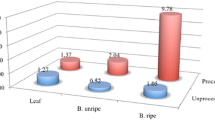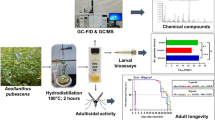Abstract
The relationships between physicochemical parameters of majority components of Eucalyptus essential oils and their insecticide effect were evaluated on Aedes aegypti (L.) (Diptera: Culicidae). The octanol–water partition coefficients of the monoterpenes were estimated by the atom/fragment contribution method and the vapor pressures were determined by our laboratory in previous studies. The larvicidal activity (LC50 (ppm)) and knockdown effect (KT50 (min)) of each component was determined. The results show that the toxicity of EOs main components of Eucalyptus on adults and larvae of A. aegypti is strongly related to their physicochemical properties (vapor pressure and Log P). However, the interaction of both variables (vapor pressure * Log P) explains the toxicological phenomenon more precisely. The regression models were expressed as follows: KT 50(min) = − 10.9 + 3.7 * Log P + 1.9 * 1/Pvapor (R2 = 0.80; F = 42.5) and LC 50(ppm) = − 94.3 + 438.6 * 1/Log P + 2.8 * 1/Pvapor (F = 57.8; R2 = 0.85). The six evaluated components present different functional groups. Therefore, it was considered to evaluate the monoterpenes as a group and separated in two groups: oxygenated monoterpenes (α-terpineol, 4-terpineol, and 1,8-cineole) and terpene hydrocarbons (γ-terpinene, p-cymene, and α-pinene). The results show the regression models for each group as follows: (A) oxygenated terpenes: KT 50(min) = − 515.3 + 1613.2 ∗ 1/Log P + 5, 2 ∗ 1/Pvapor (F = 3176.7 R2 = 0.99) and LC 50(ppm) = − 1679.4 + 5402.1 ∗ 1/Log P + 12.7 ∗ 1/Pvapor (F = 282.9; R2 = 0.99). (B) Hydrocarbons terpenes: KT 50(min) = 18.2 − 58.3 * 1/Log P + 2.7 * 1/Pvapor (F = 171.7; R2 = 0.97) and LC 50(ppm) = − 21.1 + 174.9 ∗ 1/Log P − 14.3 ∗ 1/Pvapor (F = 410.0; R2 = 0.99). The association between the toxic effect of the evaluated monoterpenes against A. aegypti and the physicochemical properties can be better described when they are separated into functional groups (hydrocarbons vs. oxygenated terpenes).
Similar content being viewed by others
References
Amer A, Mehlhorn H (2006) Larvicidal effects of various essential oils against Aedes, Anopheles, and Culex larvae (Diptera, Culicidae). Parasitol Res 99:466–472
Batish DR, Singh HP, Kohli RK, Kaur S (2008) Eucalyptus essential oil as a natural pesticide. Forest Ecol Manage 256:2166–2174
Chavasse DC, Yap HH (1997) Chemical methods for the control of vectors and pests of public health importance. World Health Organization, Geneva
Christophers SR (1960) Aedes aegypti (L.), the yellow fever mosquito. Its life history, bionomics, and structure. Cambridge University Press, London, p 739
Coats JR (1994) Risks from natural versus synthetic insecticides. Annu Rev Entomol 39:489–515
Corbet SA, Tiley C, Moorhouse T, Giam C, Pursglove S, Raby J, Rich M (2000) Surface films as mosquito larvicides: partitioning the mode of action. Entomologia experimentalis et applicata 94:295–307
Elango G, Bagavan A, Kamaraj C, Abduz Zahir A, Abdul Rahuman A (2009) Oviposition-deterrent, ovicidal, and repellent activities of indigenous plant extracts against Anopheles subpictus Grassi (Diptera: Culicidae). Parasitol Res 105:1567–1576
Eldridge BF (2005) Mosquitoes, the culicidae. In: Marquardt WH (ed) Biology of disease vectors, 2nd edn. Elsevier Academic, Burlington, pp 95–113
Enan P (2001) Insecticidal activity of essential oils: octopaminergic sites of action. Comparative Biochemistry and Physiology Part C 130:325–337
Evans P (1980) Biogenic amines in the insect nervous system. Adv. Insect Physiol 15:317–473
Fahmy MAH, Mllipudi NM, Roy Fukuto R (1978) Selective toxicity of N,N’-Thiodicarbamates. J Agric Food Chem vol. 26 (3)
Govindarajan M, Jebanesan A, Pushpanathan T (2008) Larvicidal and ovicidal activity of Cassia fistula Linn. leaf extract against filarial and malarial vector mosquitoes. Parasitol Res 102:289–292
Hoskovec M, Grygarová D, Cvacká J, Streinz L, Zima J, Pverevkin S, Koutek B (2005) Determining the vapor pressures of plant volatiles from gas chromatographic retention data. J Chromat A 1083:161–172
Houghton P, Ren Y, Howes M (2006) Acetylcholinesterase inhibitors from plants and fungi. Nat Prod Rep 23:181–199
Isman M (1999) Pesticides based on plant essential oils. Pesticide Outlook 10:68–72
Isman MB (2000) Plant essential oils for pest and disease management. Crop Prot 19:603–608
Lee B, Choi W, Lee S, Park B (2001) Fumigant toxicity of essential oils and their constituent compounds towards the rice weevil, Sitophilus oryzae (L.). Crop Prot 20:317–320
Litchfield JT, Wilcoxon FJ (1949) A simplified method of evaluating dose-effect experiments. J Exp Ther 96:99–100
Lucia A, Gonzalez Audino P, Seccacini E, Licastro S, Zerba E, Masuh HM (2007) Larvicidal effect of Eucalyptus grandis essential oil and turpentine and their major components on Aedes aegypti larvae. J Am Mosq Control Assoc 23:299–303
Lucia A, Juan LW, Zerba E, Harrand L, Marcó M, Masuh H (2012) Validation of models to estímate the fumigant and larvicidal activity of Eucalyptus essential oils against Aedes aegypti (Diptera: Culicidae). Parasitol Res 110:1675–1686
Lucia A, Licastro S, Zerba E, Gonzalez Audino P, Masuh H (2009) Sensitivity of Aedes aegypti adults (Diptera: Culicidae) to the vapors of Eucalyptus essential oils. Biores Technol 100:6083–6087
Lucia A, Licastro S, Zerba E, Masuh H (2008) Yield, chemical composition andbioactivity of essential oils from twelve species of Eucalyptus on Aedes aegypti (L.) larvae (Diptera: Culicidae). Ent Exp Appl 129:107–114
Meylan WM, Howard PH (1995) Atom/fragment contribution method for estimating octanol–water partition coefficients. J Pharm Sci 84:83–92
Michaelakis A, Papachristos D, Kimbaris A, Koliopoulos G, Giatropoulos A, Polissiou MG (2009) Citrus essential oils and four enantiomeric pinenes against Cx. pipiens (Diptera: Culicidae). Parasitol Res 105(3):769–773
Mill PJ (1985) Structure and physiology of the respiratory system. In: En Kerkut GA, Gilbert LI (eds) Comprehensive insect physiology biochemistry and pharmacology, vol 3. Pergamon Press, Oxford, pp 517–593
Papachristos DP, Stamopoulos DC (2002) Toxicity of vapors of three essential oils to the immature stages of Acanthoscelides obtectus (Say) (Coleoptera: Bruchidae). J Stored Prod Res 38:117–128
Priestley C, Williamson E, Wafford K, Satelle D (2003) Thymol, a constituent of thyme essential oil, is a positive allosteric modulator of human GABAA receptors and a homo-oligomeric GABA receptor from Drosophila melanogaster. Br J Pharmacol 140:1363–1372
Rahuman AA, Bagavan A, Kamaraj C, Saravanan E, Zahir AA, Elango G (2009) Efficacy of larvicidal botanical extracts against Culex quinquefasciatus Say (Diptera: Culicidae). Parasitol Res 104:1365–13
Rice P, Coats R (1994) Insecticidal properties of several monoterpenoids to the house fly (Diptera: Muscidae), red flour beetle (Coleoptera: Tenebrionidae), and Southern corn rootworm (Coleoptera: Chrysomelidae). J Econ Entomol 87:1172–1179
Taverner DP, Gunning RV, Kolesik P, Bailey TP, Inceoglu AB, Hammock B, Roush TR (2001) Evidence for direct neural toxicity of a “Light Oil” on the peripheral nerves of Light brown Apple Moth. Pestic Biochem Physiol 69:153–165
Throne JE, Weaver DK, Chew V, Baker JE (1995) Probit analysis of correlated data: multiple observations over time at one concentration. J Econ Entomol 88:1510–1512
Tisserand R, Balacs T (1995) Essential oils safety: a guide for health care professionals. Churchill Livingstone, London
Toloza AC, Zygadlo J, Mougabure Cueto G, Biurrun F, Zerba E, Picollo MI (2006) Fumigant and repellent properties of essential oils and component compounds against permethrin-resistant Pediculus humanus capitis (Anoplura: Pediculidae) from Argentina. J Med Entomol 43(5):889–895
Van Roon A, Parsons JR, Govers HAJ (2002) Gas chromatographic determination of vapor pressure and related thermodynamic properties of monoterpenes and biogenically related compounds. J Chromat A 955:105–115
Weinzieri RA (2000) Botanical insecticides, soaps, and oils. In: Rechcigl JE, Rechcigl NA (eds) Biological and biotechnological control of insect pests. Lewis, Boca Raton
Weinzieri RA, Palevitch D, Craker L (1994) Volatile oils as potential insecticides. Herb Spice Med Plant Dig 12:1–8
Welling W, Paterson GD (1985) Toxicodynamics of insecticides (Capitulo 16). In: En Kerkut GA, Gilbert LI (eds) Comprehensive insect physiology biochemistry and pharmacology. Volumen 12, Insect Control. Pergamon Press, Oxford, pp 603–646
Woodring J, Mcbride L, Fields P (1989) The role of octopamine in handling and exercise-induced hyperglycemia and hyperlipaemia in Acheta domesticus. J Insect Physiol 35:613–617
Author information
Authors and Affiliations
Corresponding author
Rights and permissions
About this article
Cite this article
Lucia, A., Zerba, E. & Masuh, H. Knockdown and larvicidal activity of six monoterpenes against Aedes aegypti (Diptera: Culicidae) and their structure-activity relationships. Parasitol Res 112, 4267–4272 (2013). https://doi.org/10.1007/s00436-013-3618-6
Received:
Accepted:
Published:
Issue Date:
DOI: https://doi.org/10.1007/s00436-013-3618-6




